I can’t help but be charmed by the Chihuahua Poodle Mix. This small dog, a mix between a Chihuahua and a Poodle, is so small it can fit comfortably in your hands, much like a teacup poodle.
Despite this breed’s size, these dogs are full of energy. They are always ready to run and play, showing a level of enthusiasm that’s impressive for their size. But they’re also just as happy being held in your arms, making them a lively yet affectionate pet.
That’s not all; there’s so much to learn about this fascinating pet. Hence, in this article, I’ll take you through everything, from their unique personality traits to their care needs. Drawing from my hands-on experience with this breed, I’ll share insights into their health considerations and tips for training and socialization. Let’s get started!
TABLE OF CONTENTS
- Chihuahua Poodle Mix Breed Summary
- Breed Origin and History of the Chihuahua Poodle Mix
- Chihuahua Poodle Mix Appearance
- Chihuahua Poodle Mix Personality and Temperament
- Caring for a Chihuahua Toy Poodle Mix
- How to Train a Chipoo
- Feeding Guide for Your Chihuahua Toy Poodle Mix
- Common Health Concerns for the Chihuahua Poodle Mix
- FAQs on Chihuahua Toy Poodle Mix
- Maybe You Need a Chihuahua Poodle Mix
- More Chihuahua and Poodle Mixes
Chihuahua Poodle Mix Breed Summary
| Breed Mix Name: | Chihuahua Poodle Mix, Chi-Poo |
| Size: | 7-15 inches |
| Weight: | 7-20lb |
| Lifespan: | 15 years |
| Coat: | Medium single coat |
| Color: | Black, white, brown and grey |
| Do They Shed: | Minimal |
| Temperament: | Lovable, funny, playful, bossy and independent |
| Intelligence: | High |
| Socialization: | Socializes best with its own family members |
| Destructive Behavior: | Can bite if handled roughly |
| People Skills: | Often shy around strangers |
| Good with Children: | Yes (age 10+ only) |
| Activity Levels: | Moderate |
Breed Origin and History of the Chihuahua Poodle Mix
When breeding a Chihuahua with a Poodle to create a Chihuahua Poodle Mix (often referred to as a Chi-Poo), the Poodle parent is typically a Toy Poodle. This choice is mainly due to size compatibility; Toy Poodles are smaller than Standard and Miniature Poodles, making them a more suitable match for the diminutive size of a Chihuahua. The resulting Chi-Poo puppies inherit traits from both breeds but are small in size, similar to their Toy Poodle and Chihuahua parents.
This toy dog resembles a Teacup Poodle just with a slightly longer body. The major appeal of these adorable little dogs is their playful, puppy-like nature that lasts into their adult years. It is like having a puppy that never grows up!
Chipoos are surprisingly independent and resilient for such a small dog and are much easier to care for than other toy breeds. To learn more about the Chihuahua Toy Poodle Mix, let us discuss the parent breeds.
Chihuahua
My time with these little dogs has given me a deep appreciation for their unique qualities. Chihuahuas originated from Mexico, named after the Mexican state of Chihuahua. It’s believed that they descend from the Techichi, a companion dog favored by the Toltec civilization in Mexico. The modern Chihuahua we know today was bred in the 19th Century and gained popularity in the United States in the early 20th Century.
Historically, Chihuahuas were bred for companionship, which they excelled at. They’re one of the smallest dog breeds, and their breeding has focused on maintaining this small size. Over my years working with them, I’ve noticed that breeders often emphasize either the apple head or deer head varieties, each with distinct skull shapes.
Chihuahuas are tiny, typically weighing no more than 6 pounds. They come in two varieties: the apple-headed Chihuahua, with a rounded skull and close-set eyes, and the deer-headed Chihuahua, with a longer muzzle and larger ears. They can have either short or long hair in a variety of colors and patterns.
From my experience, Chihuahuas are lively, confident, and often quite bold despite their small size. They can be fiercely loyal to their owner, sometimes to the point of being over-protective. This makes socialization crucial from a young age. They’re intelligent and can be trained, but their stubborn streak sometimes poses a challenge. Despite their sassy nature, they crave affection and love being close to their humans, often burrowing under blankets for comfort and warmth.
Chihuahuas are wonderful for those living in smaller spaces like apartments, as they don’t require as much room to move around. However, their small size doesn’t stop them from having a big personality, something I find both endearing and amusing in my daily interactions with them.
Toy Poodle
Now, let’s talk about the other half of the Chihuahua Poodle Mix equation: the Toy Poodle. My experience with Toy Poodles has always been delightful, as they are as intelligent as they are charming.
The Poodle, although often associated with France, actually originated in Germany as a water retriever. The name “Poodle” comes from the German word “Pudel,” which means to splash in the water. The breed was later standardized in France. Toy Poodles were bred down from the larger Standard Poodle, primarily for companionship among the European elite.
Toy Poodles are the smallest variant of the breed, bred specifically for their compact size. They have all the qualities of Standard Poodles but in a much smaller package. Over the years, breeders have worked to maintain the breed’s health and intelligence, while also focusing on the unique size and coat qualities.
Toy Poodles stand up to 10 inches tall and are very lightweight. They are well-known for their curly, hypoallergenic coats, which come in a variety of colors. Their hair is unique—it’s more like human hair than fur, which minimizes shedding. This characteristic makes them a good choice for people with allergies.
I’ve found Toy Poodles to be extremely intelligent and easy to train, thanks to their eager-to-please nature. They are also known for their loyalty and affectionate behavior. Despite their small size, they have a lively spirit and enjoy being active. One thing that always stands out to me is their sensitivity; they are very attuned to their owners’ emotions, making them excellent companions.
Toy Poodles, much like their larger counterparts, require mental stimulation to stay happy. They enjoy learning new tricks and thrive in environments where they can engage both physically and mentally. Their sociable nature makes them great family pets, and they usually get along well with other animals and children.
So, when you combine the characteristics of a Toy Poodle with those of a Chihuahua, you get a mix that’s small in size but big in personality, intelligence, and charm.
Chihuahua Poodle Mix Appearance
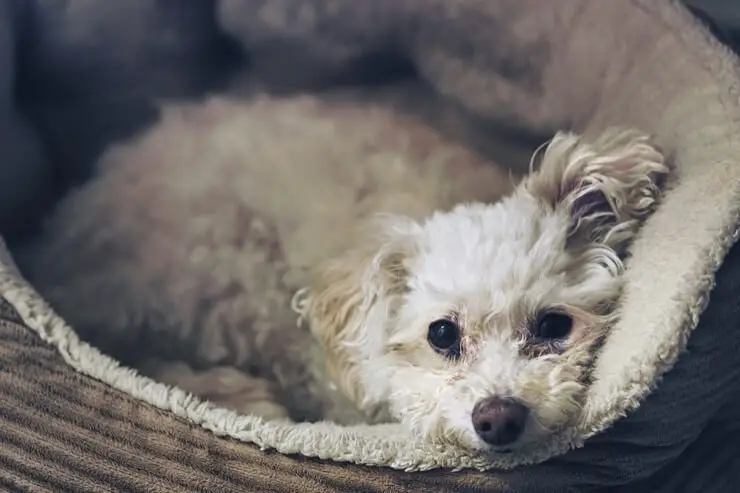
From Adobe Stock
I’ve been continually amazed by their diverse looks, which blend the best of both their parent breeds – the Chihuahua and the Toy Poodle.
In this section, we’ll explore the unique physical characteristics that define the Chi-Poo. From their size and build to the texture and color of their coats.
Height and Weight
The males of this delightful blend typically present a slightly larger stature, standing proud at 9 to 15 inches tall. They carry a bit more weight too, ranging from 10 to 20 pounds. This makes them perfectly sized for both cuddle sessions on the couch and active playtime in the yard.
On the other hand, the females of this mix tend to be daintier. Their height ranges from a petite 7 to 12 inches, making them ideal lap dogs. Weighing in at just 7 to 17 pounds, these little ladies embody the essence of a compact companion, easy to scoop up for a quick snuggle or to take along on your daily adventures.
Colors
The Chi-Poo showcases a remarkable array of coat colors, each contributing to the uniqueness of the breed. Black Chi-Poos are striking with their sleek, sometimes glossy coats that may feature patches of white or other hues. White Chi-Poos, enchanting in their purity, often have spots or patches of different colors.
The brown Chi-Poos range from light, creamy browns to rich, chocolate shades, often highlighted by their expressive faces. Tan or beige Chi-Poos are common, offering a spectrum from pale cream to a deeper tan. Many Chi-Poos inherit a delightful mix of colors, resulting in combinations like black and white, brown and white, or even tri-colored patterns.
Less commonly seen but incredibly captivating are the gray or silver Chi-Poos, usually a trait from the Poodle side. The warmer tones of red or apricot vary from light apricot to a more vivid red, adding to the breed’s allure.
It’s fascinating to observe how the coat color of a Chi-Poo can change over time. Puppies might darken, lighten, or shift in shades as they grow, reflecting the dynamic nature of their genetic makeup. The texture of their coat, whether curly like a Poodle or smooth like a Chihuahua, also plays a significant role in how their color is perceived.
Coat
Some Chi-Poos inherit the curly, dense coat of the Toy Poodle, soft and plush, often feeling almost wool-like with its tight curls. Others may display the shorter, smoother coat characteristic of the Chihuahua, sleek and lying flat against their body for a more streamlined look. There are also those with a wavy or lightly curled coat, subtly reflecting traits from both breeds. The length of their coat can range from short and manageable to longer and fluffier, each bringing its own charm.
The shedding and seasonal changes in a Chi-Poo’s coat depend largely on which parent breed’s traits are more dominant. Chi-Poos with a Poodle-like coat typically experience minimal shedding, their curly fur effectively trapping loose hairs. However, those with a coat leaning towards the Chihuahua side might shed more noticeably, especially during seasonal transitions like spring and fall.
Chihuahua Poodle Mix Personality and Temperament
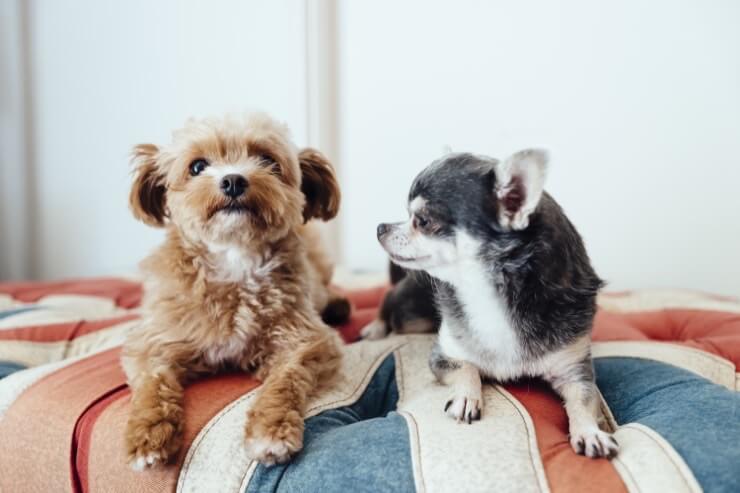
From Adobe Stock
Chihuahua Poodle mixes are even-tempered and good-natured dogs. They make cute and cuddly lap dogs and love to be carried or held.
As it is very easy to spoil them rotten they can develop a bossy streak. When you wake up in the morning, your pup’s sweet face will be the first thing you see. They will spend their day following you around right at your heels.
Even as they grow up they never lose the curiosity and playful behavior of puppyhood. Every day is a big adventure for this lovable little pooch. They are surprisingly independent for a toy breed and do not mind spending time alone.
These playful pups will keep themselves and their owners amused with all kinds of tricks. Just about anything will keep them entertained. Their energy comes in quick bursts and they enjoy short play sessions throughout the day.
Both parent breeds are known for being very chatty dogs so you will likely hear a lot of yapping from your mix. Reducing excessive barking whilst they are a puppy should be a priority.
These dogs will eagerly socialize with their family but can be shy and anxious around strangers. This anxiety will lead to much more barking and yapping. Keeping your pup close while you take them out to socialize will help them feel much more comfortable. They tend to be very suspicious of other pets but will get along with other toy dogs with similar personalities. Never keep one with a large dog or an especially pushy breed.
Caring for a Chihuahua Toy Poodle Mix
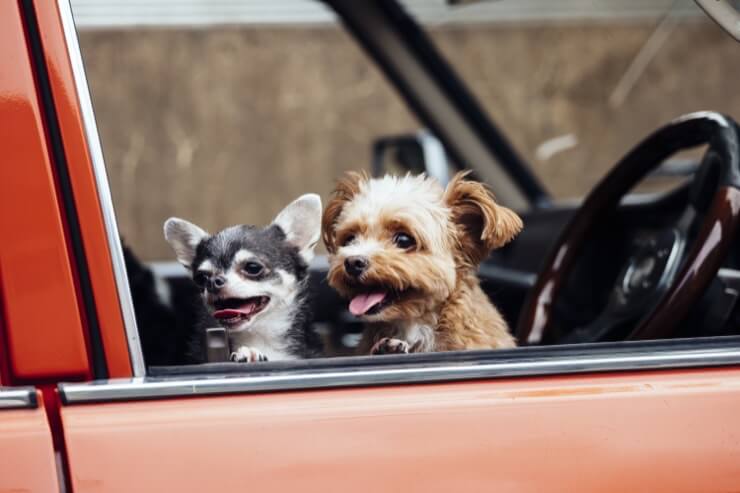
From Adobe Stock
These delightful dogs bring together the best qualities of their parent breeds, but they also have unique needs that require special attention. In this section, we’ll explore practical tips and advice to ensure you’re well-equipped to provide your Chi-Poo with a loving and nurturing environment.
Grooming
Grooming your Chi-Poo is an important part of their care routine, ensuring they not only look their best but also remain healthy and comfortable. Here’s a guide based on my experience and knowledge:
Brushing
The frequency of brushing depends on your Chi-Poo’s coat type. Daily brushing is ideal to prevent tangles and mats if they have inherited the curly Poodle coat. For Chi-Poos with shorter, smoother coats, brushing a few times a week should suffice. Use a brush suitable for their coat type; a slicker brush works well for curly coats, while a bristle brush can be good for smoother ones.
Bathing
Bathe your Chi-Poo every 3-6 weeks, depending on their coat and lifestyle. Use a dog-specific shampoo to maintain the health of their skin and coat. If they have a curly coat, ensure it’s thoroughly untangled before bathing to avoid mats.
Hair Trimming
For Chi-Poos with longer coats, regular trimming is necessary to keep their fur from getting too long, which can happen especially around the eyes, ears, and paws. You can do this at home with proper scissors or take them to a professional groomer every few months.
Ear Care
Chi-Poos can be prone to ear infections, especially if they have the floppy ears common in Poodles. Check and clean their ears regularly to prevent buildup of wax and debris.
Nail Trimming
Regular nail trimming is important to prevent discomfort and mobility issues. If you can hear their nails clicking on the floor, it’s time for a trim.
Dental Care
Dental health is crucial. Brush their teeth several times a week with dog-specific toothpaste to prevent tartar buildup and maintain overall oral health.
Remember, the grooming experience can be a bonding time for you and your Chi-Poo. Be gentle and patient, especially if they are new to grooming, and reward them with treats and praise to make it a positive experience.
Exercise
exercise is an essential part of a Chi-Poo’s routine, contributing to their physical health and mental well-being. Despite their small size, Chi-Poos inherit the energetic nature of both Chihuahuas and Poodles, so they do need regular activity. Here are some exercises I find helpful for this breed:
Daily Walks
Chi-Poos benefit greatly from daily walks. These don’t have to be overly long or strenuous; even short to moderate walks are sufficient to keep them happy and healthy. It’s a great way for them to explore the environment, socialize, and burn off energy.
Playtime
Engage your Chihuahua Toy Poodle Mix in play sessions either indoors or in a secured backyard. Games like fetch, tug-of-war, or hide-and-seek are excellent for keeping them mentally and physically stimulated.
Training Exercises
Incorporate training into their exercise routine. Chi-Poos are intelligent and can enjoy learning new tricks or commands, which is also a form of mental exercise.
Agility Training
If you have the space and resources, agility training can be a fun and engaging way to exercise your Chi-Poo. They often excel in these activities due to their intelligence and agility.
Interactive Toys
Provide them with interactive toys that challenge their mind and keep them occupied. I recommend puzzle toys where they have to work to get a treat can be particularly effective.
Social Playdates
If your Chi-Poo is sociable, arrange playdates with other small dogs. This is not only great for physical activity but also their social skills.
Routine
Establish a regular exercise routine to keep your Chi-Poo in good health. Consistency helps manage their energy levels and prevents boredom.
It’s important to remember that while Chi-Poos are energetic, they are also small and can tire easily. I recommend that you monitor their activity levels and ensure they don’t overexert themselves, especially in extreme weather conditions.
How to Train a Chipoo
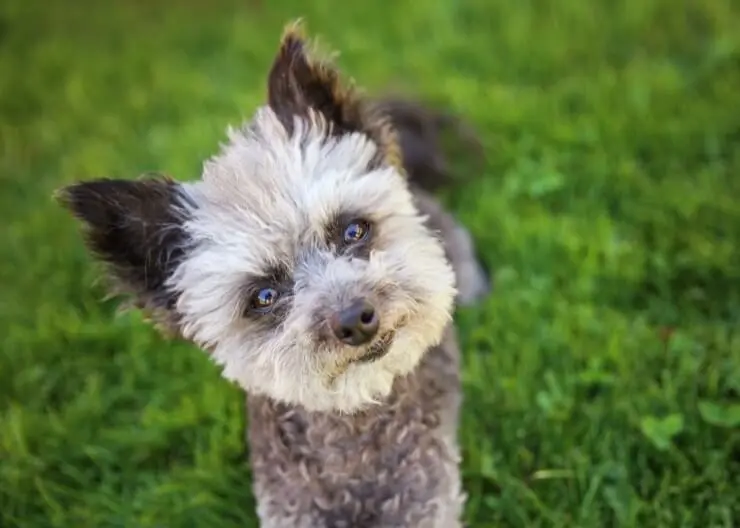
From Adobe Stock
With all of the intelligence of a Poodle combined with the stubborn nature of a Chihuahua, dog training can be quite a chore.
Fortunately, these dogs learn very fast once they are motivated to train.
Housebreaking is the biggest challenge as they have tiny bladders. Hence, take your Chihuahua Poodle mix to their potty area right after they have finished eating or playing, or right after they wake up in the morning. Reward them when they do their business in the right spot. It will take a lot of time and patience but your puppy will eventually be able to go to their potty spot on their own.
Nuisance barking and yapping is the second biggest challenge to tackle. This can be eliminated by simply ignoring it when it happens. Respect your dog’s need to communicate but do not validate them when they are just making noise for the sake of making noise. They will learn better ways to get your attention.
Mental Stimulation
Do not underestimate the high intelligence of these tiny dogs. They do not need as much stimulation as other Poodle breeds but still hate to be bored. Hence, you should give your dog their special room or pen in your house where they can amuse themselves.
Chasing games will tap into your pup’s prey instinct while they train. Get a rope or a stick for them to chase and take them out into the yard to let loose. While they chase the toy, you can practice basic commands.
Feeding Guide for Your Chihuahua Toy Poodle Mix
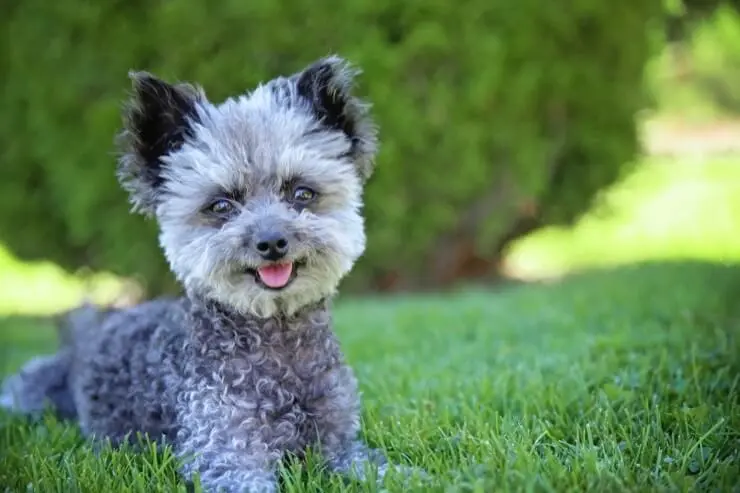
From Adobe Stock
Navigating the world of dog food, treats, and dietary needs can sometimes feel overwhelming. That’s why I’ve put together this comprehensive guide to help you understand the various feeding requirements for your Chi-Poo.
Feeding Schedule
Puppy Stage (Up to 1 Year): During the puppy stage, your Chi-Poo will require more frequent feedings to support their rapid growth and development. Typically, they should be fed three to four times a day. The portion sizes at this stage should be aligned with the recommendations on the puppy food packaging, based on your puppy’s current weight and projected adult size. It’s essential to use a high-quality puppy formula specifically designed for small breeds to ensure they’re getting the right balance of nutrients needed for healthy development.
Adult Stage (1-7 Years): As your Chi-Poo enters adulthood, you can transition to feeding them twice a day. This change helps maintain a stable metabolism and energy levels. Adult portion sizes will depend on various factors like their activity level and metabolism. Start with the suggested amounts on the dog food package and adjust as necessary. The adult dog food you choose should be a well-balanced formula suitable for small breeds, rich in protein, and meeting all their nutritional requirements.
Senior Stage (8 Years and Older): In their senior years, Chi-Poos still benefit from being fed twice daily, but you may need to adjust the portion size to suit their slower metabolism and reduced activity levels. Senior dogs typically need fewer calories to avoid weight gain. Choose a senior dog food that’s formulated to support aging joints, easier digestion, and overall health, and that is easy to digest and supports cognitive health.
Special Dietary Considerations
For your Chi-Poo, choose a high-quality dry kibble formulated for small or toy breeds. These formulas are designed to meet the nutritional needs of small dogs like Chi-Poos. Look for foods where protein is the primary ingredient, with minimal carbohydrates and fats. Avoid foods with unnecessary fillers or artificial additives. Be attentive to any signs of food allergies or sensitivities, and consult your vet for tailored dietary advice, especially if your Chi-Poo shows signs of digestive upset.
Treats and Snacks
Treats are an excellent tool for training and bonding, but they should be given in moderation. I recommend that treats make up no more than 10% of your Chi-Poo’s daily caloric intake. Choose healthy treats like small pieces of cooked chicken or vegetables like carrots. Be cautious with human foods, as some can be harmful. Treats are a supplement to their diet, not a replacement, so choose wisely.
Hydration
Ensuring your Chi-Poo stays well-hydrated is crucial. Always provide access to fresh, clean water. Small dogs like Chi-Poos can be prone to dehydration, especially if they are active or in hot environments. Encourage regular drinking by placing water bowls in areas they can access. If you notice changes in their drinking habits, it could be a sign of health issues, so keep a watchful eye.
Common Health Concerns for the Chihuahua Poodle Mix
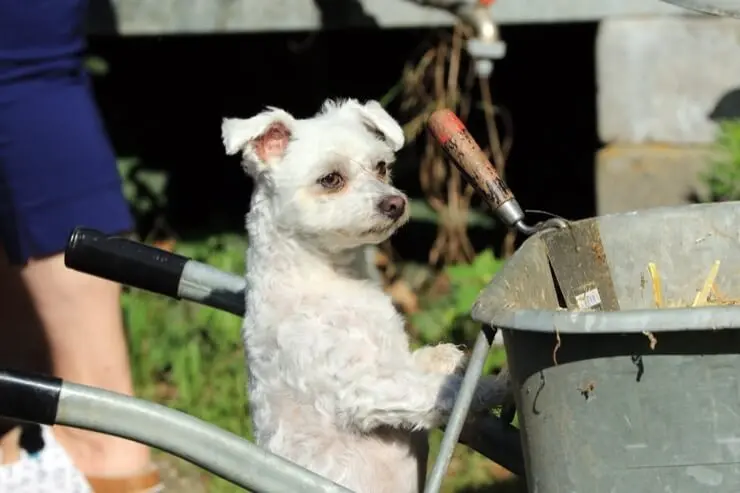
From Adobe Stock
The Chihuahua Toy Poodle Mix can be predisposed to certain health issues. Understanding these potential problems can help you spot early signs and seek timely veterinary care. Here are some of the most common health issues seen in Chi-Poos:
Dental Problems
Dental issues are common in small breeds like the Chi-Poo, often due to their small mouths and crowded teeth. This can lead to problems like tartar buildup, gum disease, and tooth loss. Symptoms include bad breath, difficulty eating, and visible plaque or tartar.
Patellar Luxation
Patellar luxation, a condition where the kneecap dislocates from its normal position, is frequently seen in small breeds. It can be caused by genetic factors and can range from mild, where the kneecap occasionally slips out of place, to severe, requiring surgical intervention. Symptoms include limping, abnormal gait, or sudden episodes of leg lifting during activity. Early detection and treatment are crucial for managing this condition.
Hypoglycemia
Hypoglycemia, or low blood sugar, can occur in small breeds like the Chi-Poo, especially if they skip meals or exert a lot of energy without eating enough. Symptoms include weakness, lethargy, trembling, and in severe cases, seizures. Ensuring regular, balanced meals and having a vet-approved sugar supplement on hand for emergencies is important for managing this risk.
Tracheal Collapse
This condition, more common in small breeds, involves the weakening and collapsing of the tracheal rings in the neck, leading to breathing difficulties. Causes can be genetic or due to environmental factors like obesity. Symptoms include a honking cough, difficulty breathing, and intolerance to exercise. Weight management and avoiding stress on the neck with harnesses instead of collars can help.
Progressive Retinal Atrophy (PRA)
PRA is a genetic condition that can occur in Chi-Poos, leading to the gradual deterioration of the retina and potential blindness. Early symptoms are subtle, like night blindness or dilated pupils. While there’s no cure, understanding and preparing for the progression can help manage a dog’s quality of life.
FAQs on Chihuahua Toy Poodle Mix
Is the Chihuahua Poodle Mix a good family dog?
The Chihuahua Poodle Mix makes an excellent dog for families with older children (10+ years old). Young children are often too noisy for these delicate dogs to handle. These delicate pooches can snap or bite if handled roughly.
What is the temperament of a Chihuahua Poodle Mix?
The Chi-Poo generally has a lively and affectionate temperament. They are known for their intelligence and eagerness to please, traits inherited from their Poodle lineage, combined with the boldness and loyalty typical of Chihuahuas. This makes them alert, sociable, and great companions, although they can sometimes be wary of strangers and may need proper socialization from a young age.
Are Chihuahua Poodle Mixes easy to train?
Yes, Chi-Poos are generally easy to train due to their intelligence and desire to please their owners. However, they can inherit a stubborn streak from the Chihuahua side, so patience and consistency are key. Positive reinforcement techniques work best for training this breed.
Do Chihuahua Poodle Mixes require a lot of grooming?
Their grooming needs depend largely on which parent breed’s coat they inherit. A mix with a Poodle-like curly coat requires regular grooming to prevent matting, including frequent brushing and professional grooming every few months. Those with a shorter Chihuahua-like coat require less intensive grooming but still benefit from regular brushing.
Are Chihuahua Poodle Mixes good with other pets?
Chi-Poos can get along well with other pets, especially if they are raised with them or properly socialized from a young age. Their small size and playful nature often make them good companions for other small dogs or even cats. However, supervision is recommended during initial interactions.
Is the Chihuahua Poodle Mix suitable for apartment living?
Absolutely, the Chi-Poo is well-suited for apartment living due to its small size and moderate exercise needs. They adapt well to smaller living spaces as long as they receive adequate daily exercise and mental stimulation.
Can Chihuahua Poodle Mixes be left alone?
Chi-Poos can manage short periods alone, but they thrive on companionship and can develop separation anxiety if left alone for extended periods. It’s important to gradually train them to be comfortable alone and provide them with toys and activities to keep them occupied.
How long does a Chihuahua Poodle Mix live?
These mixes typically live up to 15 years. However, a particularly healthy pooch may reach 20 years old!
How much does a Chihuahua Poodle Mix cost?
Expect to pay about $800 for one of these pups.
Maybe You Need a Chihuahua Poodle Mix
A Chihuahua Poodle mix is a wonderful furry friend to have. Just about anybody can find a place for them in their home and heart. They are so easy to care for that new owners should have very little trouble with them. However, their bossiness can sometimes catch a new owner off guard.
These loving and playful dogs never truly lose their youth. It is impossible to be in a bad mood with one of these funny little pups around to put a smile on your face. When playtime is over, your Chihuahua Toy Poodle Mix will be ready to cuddle on the couch with you.
More Chihuahua and Poodle Mixes
Want a Chihuahua mix or Poodle mix but aren’t keen on the Chihuahua Poodle Mix? Check out these other hybrid dog breeds:
Chihuahua Mixes
- Chihuahua Terrier Mix
- Chiweenie
- Jack Russel Chihuahua Mix
- Shih Tzu Chihuahua Mix
- Pomchi
- Pomeranian Chihuahua Mix
- Chihuahua Great Dane
- Chorkie
- Chug Dog







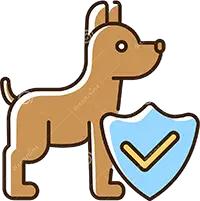

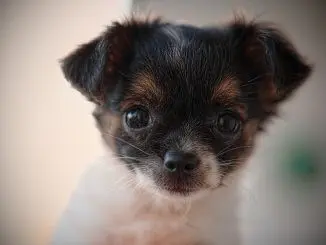
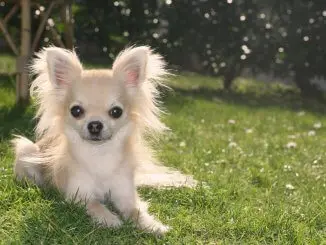
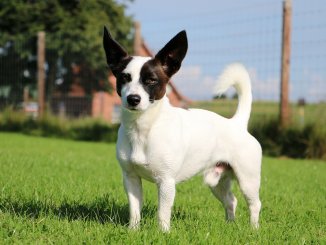
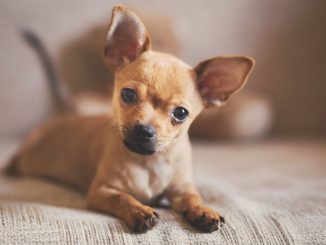

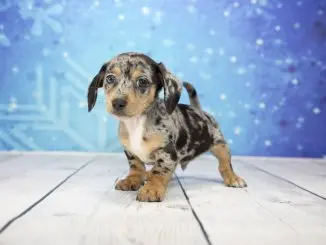
This is the best dog I ever loved like a child her name is ly ly she is eighteen years old blind and deaf solid white more like a poodle characteristics and healthier than I am l am 65 years old